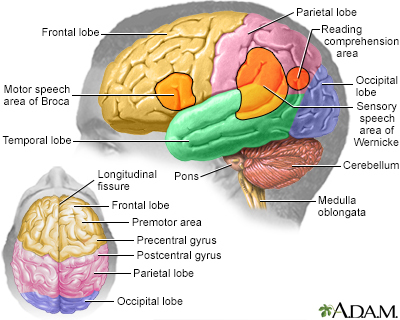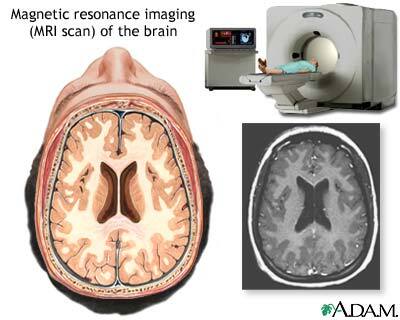Definition
Primary lymphoma of the brain is cancer of white blood cells that starts in the brain.
Alternative Names
Brain lymphoma; Cerebral lymphoma; Primary lymphoma of the central nervous system; PCNSL; Lymphoma - B-cell lymphoma, brain
Causes
The cause of primary brain lymphoma is not known.
People with a weakened immune system are at high risk for primary lymphoma of the brain. Common causes of a weakened immune system include HIV/AIDS and having had an organ transplant (especially heart transplant).
Primary lymphoma of the brain may be linked to Epstein-Barr Virus (EBV), especially in people with HIV/AIDS. EBV is the virus that causes mononucleosis.
Primary brain lymphoma is more common in people ages 45 to 70. The rate of primary brain lymphoma is rising. Almost 1,500 new patients are diagnosed with primary brain lymphoma every year in the United States.
Symptoms
Symptoms of primary brain lymphoma may include any of the following:
- Changes in speech or vision
- Confusion or hallucinations
- Seizures
- Headaches, nausea, or vomiting
- Leaning to one side when walking
- Weakness in hands or loss of coordination
- Numbness to hot, cold, and pain
- Personality changes
- Weight loss
Exams and Tests
The following tests may be done to help diagnose a primary lymphoma of the brain:
Treatment
Primary lymphoma of the brain is often first treated with corticosteroids. These medicines are used to control swelling and improve symptoms. The main treatment is with chemotherapy.
Younger people may receive high-dose chemotherapy, possibly followed by an autologous stem cell transplant.
Radiation therapy of the whole brain may be done after chemotherapy.
Boosting the immune system, such as in those with HIV/AIDS, may also be tried.
Outlook (Prognosis)
Without treatment, people with primary brain lymphoma survive for less than 6 months. When treated with chemotherapy, half of the patients will be in remission 10 years after being diagnosed. Survival may improve with autologous stem cell transplant.
Possible Complications
Possible complications include:
- Chemotherapy side effects, including low blood counts
- Radiation side effects, including confusion, headaches, nervous system (neurologic) problems, and tissue death
- Return (recurrence) of the lymphoma
References
Grommes C, DeAngelis LM. Primary CNS lymphoma. J Clin Oncol. 2017;35(21):2410-2418. PMID: 28640701 pubmed.ncbi.nlm.nih.gov/28640701/.
National Cancer Institute website. Primary CNS lymphoma treatment (PDQ) - health professional version. www.cancer.gov/cancertopics/pdq/treatment/primary-CNS-lymphoma/HealthProfessional. Updated December 22, 2021. Accessed June 8, 2022.
National Comprehensive Cancer Network website. NCCN clinical practice guidelines in oncology (NCCN guidelines): central nervous system cancers. Version 1.2022. www.nccn.org/professionals/physician_gls/pdf/cns.pdf.. Updated June 2, 2022. Accessed June 8, 2022.
Roque A, Hochberg FH, Baehring JM. Primary nervous system tumors in adults. In: Jankovic J, Mazziotta JC, Pomeroy SL, Newman NJ, eds. Bradley and Daroff's Neurology in Clinical Practice. 8th ed. Philadelphia, PA: Elsevier; 2022:chap 74.


